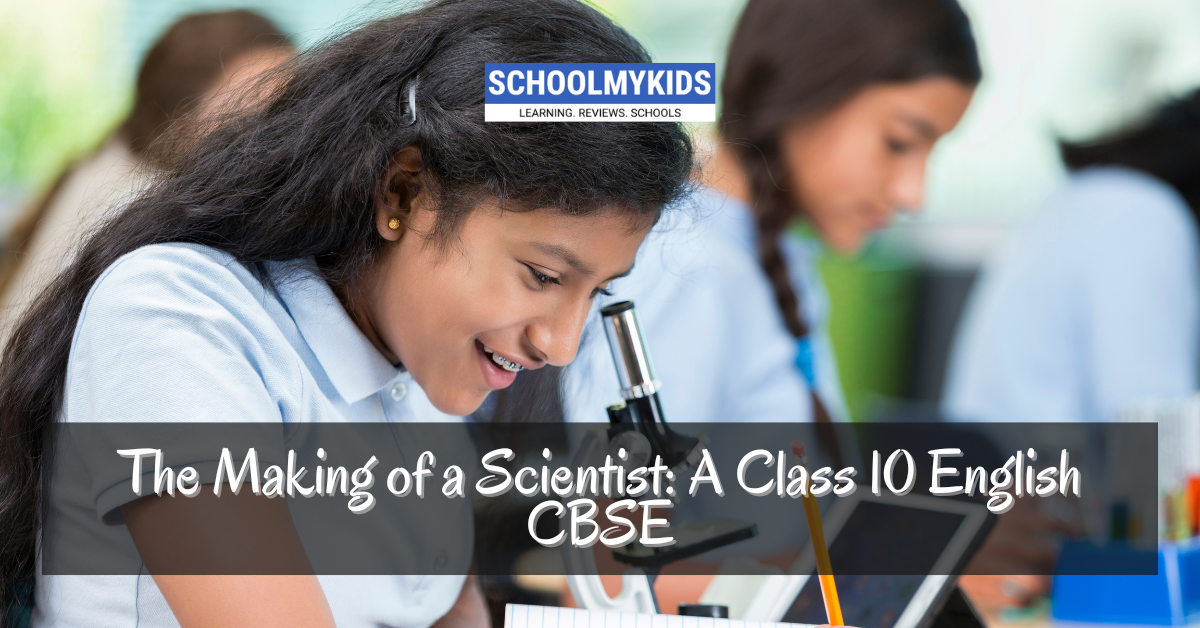“The Making of a Scientist” is a chapter from the Class 10 CBSE English textbook, “Footprints without Feet”
Summary
“The Making of a Scientist” is a captivating lesson from Class 10 English that explores the journey of Richard Ebright, an acclaimed scientist. Ebright’s story is an inspiration for young minds, showcasing how curiosity, dedication, and hard work can lead to remarkable achievements.
Ebright’s journey began in childhood, fueled by his interest in butterflies. His mother played a pivotal role in nurturing his curiosity by providing books and encouraging his explorations. Ebright’s meticulous nature led him to collect and study butterflies, eventually winning a series of scientific competitions.
His significant breakthrough came when he discovered an unknown cell in a monarch butterfly, leading to groundbreaking research on the theory of cells. This discovery laid the foundation for his future as a distinguished scientist. Ebright’s story emphasizes the importance of perseverance, passion, and the support of mentors in the making of a scientist.
Analysis
Richard Ebright’s story is more than just an account of scientific achievements; it is a testament to the power of curiosity and the impact of a nurturing environment. The narrative underscores several key themes:
- Curiosity and Passion: Ebright’s fascination with butterflies sparked a lifelong passion for science. His curiosity drove him to explore, experiment, and make significant discoveries.
- Mentorship and Support: Ebright’s mother played a crucial role by providing resources and encouragement. This highlights the importance of guidance and support in a child’s educational journey.
- Perseverance: Ebright faced challenges and failures, but his determination and hard work were instrumental in his success. This teaches students the value of resilience and persistence.
- Impact of Early Interests: Ebright’s early interests and hobbies were stepping stones to his career. This suggests that nurturing children’s interests can lead to future accomplishments.
Ebright’s story is a source of inspiration, illustrating that with curiosity, support, and perseverance, anyone can achieve greatness in their chosen field.
20 Questions and Answers on “The Making of a Scientist”
- Who is the central figure in “The Making of a Scientist”?
- Richard Ebright.
- What was Richard Ebright’s initial interest as a child?
- Butterflies.
- How did Ebright’s mother support his interest in science?
- She provided books, took him on field trips, and encouraged his scientific inquiries.
- What significant discovery did Ebright make about monarch butterflies?
- He discovered an unknown cell in the monarch butterfly, contributing to the theory of cells.
- What lesson does Ebright’s story convey about curiosity?
- Curiosity is a driving force for learning and discovery.
- How did Ebright’s early hobbies influence his career?
- His early interest in butterflies led to his passion for science and significant scientific contributions.
- What role did perseverance play in Ebright’s journey?
- Perseverance helped him overcome challenges and achieve success in his scientific endeavors.
- What competitions did Ebright participate in as a student?
- Scientific competitions and fairs.
- How important is mentorship according to Ebright’s story?
- Mentorship is crucial as it provides guidance, support, and encouragement.
- What message does the story send about the impact of early interests?
- Early interests can shape future careers and lead to significant achievements.
- What did Ebright’s discovery about cells contribute to?
- It contributed to the theory of cells and further scientific research.
- Why is Ebright’s story considered inspirational?
- It shows how passion, hard work, and support can lead to remarkable success.
- What does Ebright’s journey teach about handling failures?
- It teaches that failures are part of the learning process and perseverance is key to overcoming them.
- How did Ebright balance his academic and scientific pursuits?
- Through dedication, time management, and a strong interest in his studies.
- What can students learn from Ebright’s approach to challenges?
- To remain resilient, curious, and dedicated in the face of obstacles.
- How did Ebright’s findings impact the scientific community?
- They provided new insights and advanced the understanding of biological processes.
- What is a key factor in becoming a successful scientist according to Ebright’s story?
- A combination of curiosity, hard work, and mentorship.
- How does Ebright’s story highlight the importance of self-motivation?
- His self-driven explorations and studies led to significant discoveries.
- What role do competitions play in a budding scientist’s life as seen in Ebright’s story?
- They provide a platform to showcase talents and gain recognition.
- What is the overall theme of “The Making of a Scientist”?
- The journey of scientific discovery is fueled by curiosity, perseverance, and support.
Conclusion
“The Making of a Scientist” is a valuable lesson for Class 10 students, illustrating the importance of curiosity, perseverance, and support in achieving success. Richard Ebright’s story serves as an inspirational guide for young minds, encouraging them to explore their interests and pursue their passions with determination.









Be the first one to comment on this story.